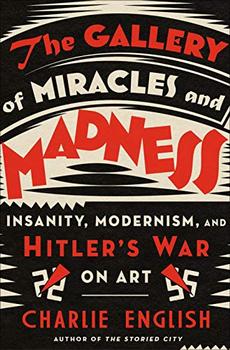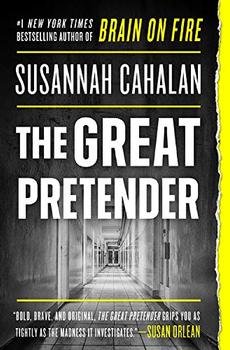Summary | Excerpt | Reviews | Beyond the book | Read-Alikes | Genres & Themes | Author Bio

 Book Reviewed by:
Book Reviewed by:
Peggy Kurkowski
Buy This Book
In the annals of Nazi crimes, the industrialized killing of human beings didn't begin with the Jewish concentration camps. In the early days of World War II, failed-artist-turned-Fuhrer Adolf Hitler ordered the mass roundup of the mentally ill, severely disabled and others he believed contributed to the "degeneration" of the Aryan bloodline. In The Gallery of Miracles and Madness: Insanity, Modernism, and Hitler's War on Art, Charlie English makes the case that this was the murderous extension of Hitler's vitriolic culture war against modern, "degenerate" art, and the human beings he deemed "life unworthy of life."
English, a former journalist at the Guardian and author of two previous books (The Storied City and The Snow Tourist), weaves a compelling and richly researched study that begins with psychiatrist and decorated combat veteran, Hans Prinzhorn. In 1919, Prinzhorn was home from the war and freshly installed at the University of Heidelberg Psychiatric Clinic, where he intended to build the largest collection of psychiatric art the world had ever known. As he amassed his collection of patient artwork, Prinzhorn (who had a PhD in art history) underwent a "transcendent experience" that went beyond the purely diagnostic.
Examining the variety of art, whether it was crayon drawings, paintings or tiny sculptures made from chewed bread, he realized, as English explains, "he had uncovered an untapped source of schizophrenic creativity that matched or even surpassed professional art in its expressive power." After two-and-a-half years of study, his monumental book Bildnerei Der Geisteskranken (Artistry of the mentally ill) was published in 1922 to wide acclaim and controversy. It became the "bible" to a new generation of expressive modern artists but a travesty to hidebound cultural conservatives.
English deftly juxtaposes the intellectual and artistic ferment of 1920s Germany with the turgid drawings and morose outlook of a young, adrift Adolf Hitler, at odds with himself and the world after the country's defeat in World War I. Projecting his own failures onto the "degenerate" culture of Germany under the Weimar Republic, Hitler envisioned himself as the "artist-Fuhrer," one who could return Germany to greatness by establishing a culture based on ethnic purity and heroic depictions of the Aryan man. Thus he took aim at the modern art scene in the 1920s and '30s, culminating in the "psychiatric Holocaust" of 1940-41. English persuasively argues throughout that Hitler's "mass murder programs and his views on art were intimately connected." Hitler and his minions would seize on patient art as a tool to beat down the modern art movement: in one popular propaganda exhibit organized by Joseph Goebbels, Hitler's Minister of Propaganda, pieces from Prinzhorn's art collection were presented alongside the works of "degenerate" modern artists. The goal? To let the viewer judge who was more insane.
It was only after Germany invaded Poland on September 1, 1939, that two key orders were signed by Hitler to make his artistic "restoration" of the German ethnic community complete. These orders decreed that sterilization as the main method of combating degeneracy would be supplanted by involuntary euthanasia. The final portion of English's relatively brief study is probably the toughest to absorb, revealing as it does the sad and inhuman details around the mass incarceration and killing of mentally ill patients at several "euthanasia centers" across Germany. In all, more than 70,000 people were herded into locked rooms and gassed with carbon monoxide until they asphyxiated, their bodies burned in hastily assembled crematoriums. English makes the chilling observation that with this successful elimination of Germany's "undesirables," Hitler realized that mass genocide was, indeed, feasible.
This little-known holocaust has been sensitively rendered by English in The Gallery of Miracles and Madness, which balances the Hitlerian horrors with the immortal hope that art can provide, both to the artist and to society. The voices and artwork of these abandoned and forgotten psychiatric patients are reintroduced to a new audience with lean, empathetic prose and unforgettable images. Indeed, the book contains 16 pages of photographs and color reproductions of psychiatric art that transmit more than words ever could. This is a must-read history for anyone who cares about art, culture and — most importantly — humanity.
![]() This review
first ran in the September 8, 2021
issue of BookBrowse Recommends.
This review
first ran in the September 8, 2021
issue of BookBrowse Recommends.

If you liked The Gallery of Miracles and Madness, try these:

by Brad Meltzer, Josh Mensch
Published 2024
From the New York Times bestselling authors of The First Conspiracy and The Lincoln Conspiracy comes the little-known true story of a Nazi plot to kill FDR, Joseph Stalin, and Winston Churchill at the height of World War II.

by Susannah Cahalan
Published 2020
From "one of America's most courageous young journalists" (NPR) and the author of the blockbuster #1 New York Times bestselling memoir Brain on Fire comes a propulsive narrative history investigating the 50-year-old mystery behind a dramatic experiment that changed the course of modern medicine.





The House on Biscayne Bay
by Chanel Cleeton
As death stalks a gothic mansion in Miami, the lives of two women intertwine as the past and present collide.

The Flower Sisters
by Michelle Collins Anderson
From the new Fannie Flagg of the Ozarks, a richly-woven story of family, forgiveness, and reinvention.

The Funeral Cryer by Wenyan Lu
Debut novelist Wenyan Lu brings us this witty yet profound story about one woman's midlife reawakening in contemporary rural China.
Your guide toexceptional books
BookBrowse seeks out and recommends the best in contemporary fiction and nonfiction—books that not only engage and entertain but also deepen our understanding of ourselves and the world around us.